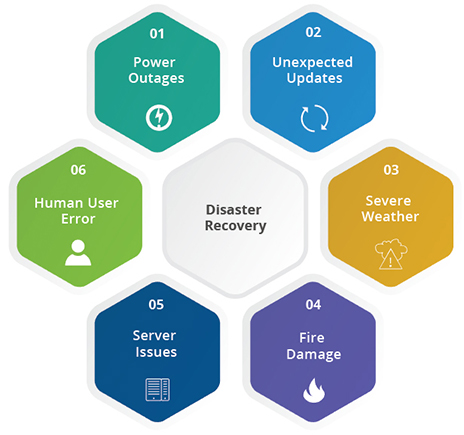- February 22, 2019
- Catagory Managed IT Services
Prime Yourself for Disaster Recovery to Maximize Business Uptime
 Every organization today is data driven, regardless of size, and it’s just a matter of when, not if, that data is put in jeopardy. For small and medium-sized business with resource and IT infrastructure constraints, it can seem an overwhelming challenge to prepare an effective disaster recovery plan and maximize business uptime.
Every organization today is data driven, regardless of size, and it’s just a matter of when, not if, that data is put in jeopardy. For small and medium-sized business with resource and IT infrastructure constraints, it can seem an overwhelming challenge to prepare an effective disaster recovery plan and maximize business uptime.
The good news is that cloud computing allows smaller organizations to enjoy the same peace of mind large enterprises have with the help of an experienced technology partner who help you lay out at plan of action when disaster strikes.
What you should expect from a solid disaster recovery plan
The point of any disaster recovery plan is to make sure there are steps in place to restore any mission critical applications and data after a disruption. It outlines all the all the activities, resources and procedures in the event of a disaster so you can ensure business uptime and return to normal operations as quickly as possible in the event of a disruption.
It starts by notifying everyone who needs to be part of the solution that there is a problem, whether it’s company staff or resources at your service provider, and outlines who’s responsible for what. Once the process is underway, the recovery phase should enable you to restore temporary operations and repair any primary system damage. There’s a lot that needs to happen during the recovery, and an effective disaster recovery plan will coordinate and facilitate communication between all parties involved.
Mapping the connections
There’s also a lot of moving pieces that must be considered. A disaster recovery plan should identify the processes that are in scope, who is responsible for those processes and all the interdependencies affected by the disaster.
Dependencies will help establish the severity of the disaster—one single glitch may be just that or could have a much broader impact on business operations. When a single resource becomes unavailable, it affects many user and customers, and disrupts multiple business processes. Here are some examples of dependencies your disaster recovery should keep in mind:
- Reporting and analytics: Collection, logging, filtering, and delivery business data to relevant stakeholders may stop working and the user interface layer may or may not be also affected.
- Interfaces: Users at all levels, including administrators, may be blocked from accessing software and systems, whether it’s on the client or server side, through web interface or downloaded application.
- Networking: Connectivity to necessary resources could be slow or disappear completely. compromised and/or significant latency issues in the network exist that result in lowered performance.
- Storage: Even if your connectivity and applications are functioning, the failure of a storage resource such as storage area network (SAN) could block access to a handful of files essential for running the business.
There are many more dependencies, and your service provider is well-equipped to help you identify them so you can quickly resolve issues and take advantage of secondary infrastructure in case of an interruption that has a broad impact on your business.
If you haven’t begun to think about disaster recovery planning or feel your plan needs an update, check out our Disaster Recovery Primer.




 Latest Blogs
Latest Blogs FAQ
FAQ